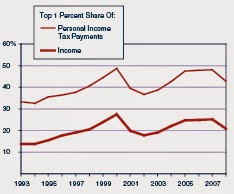If you want to look at the direction of any organization, institution, corporation or nation you can most likely determine where it is going by looking at these two factors.
It starts at the top. What is the inspiration from the leadership? Where are they trying to take the group? What tone is set? How is it communicated?
The reality is that most people follow rather than lead. They look for leadership and they also look to others around them for approval of their actions. Most people want to conform. They don't want to be an outlier. They want to fit in. They don't want to rock the boat.
That is why leadership is so important. The tone at the top quickly cascades through an organization and one voice can quickly become a chorus.
The incentives in the system are also critically important. Human beings will do what is in their best interest. Period.
Incentives drive the world. If the incentives for people are properly aligned, you will get the result you want. If the incentives are not properly aligned, you will get poor results. Whenever you get a poor result it is likely that you will find that the underlying incentives were not aligned properly.
We see this all the time in public policy. If you pay people not to work, they will not work. If you give aid to single mothers with dependent children, you will end up with more children who are dependent. If you penalize corporations by taxing repatriated earnings, they will not bring money back to the United States they earned (and were taxed on) overseas. If employers get a tax advantage for providing health care to their employees, you end up with an employer-based health system rather than an individual-based market. If you provide low-cost federal student loans, kids will go to college and colleges will be able to keep increasing tuition.
The Veterans Administration mess is a perfect example of the wrong inspiration at the top and misaligned incentives throughout the organization.
What did the VA managers see as their inspiration from the top with Barack Obama as President? What did they believe they should be focusing on at the VA? Improved health outcomes? World class healthcare technology? Better coordination of care? Where did they think they should be spending tax dollars on to improve the VA and the patient experience?
The answer. Solar and wind power.
This included spending $20 million on a solar carport in Phoenix where the VA scandal first became news.
This report from Watchdog.org provides the details.
Veterans Administration hospitals have spent at least $420 million on solar panels and windmills while vets wait months — or even lay dying — to see a doctor.
A whistleblower revealed Tuesday that seven of the patients listed on the Phoenix VA hospitals waiting list are already dead. That same Phoenix facility spent $20 million to build the nation’s largest solar carport. Phase one of the project was completed in 2011. The hospital also had an $11.4 million shortfall that year, an Inspector General’s report stated.
Where did anyone get the idea that pursuing solar and wind energy projects at the VA was more important than focusing on the patients? Do you think that those VA administrators just might have taken the cue from their leader on what was really important? There is little doubt that they heard a lot more from the President the last few years on solar energy than they ever did about improving the patient experience at the VA.
As for incentives at the VA, what happened with those? Did they get the desired result?
On its face, reducing wait times would seem to be a logical patient-centered goal that you would want to incentivize with the VA. However, with a government-controlled enterprise you don't have the checks and balances you have in the private sector. As a result, it allowed the human beings running the VA to game the system to their advantage. They simply ran two sets of books. The waiting list to determine their bonus showed they were meeting all goals. Of course, the real set of books showed many, many patients waiting months for an appointment.
In the private sector, the enterprise would see a loss of volume and revenue as disgruntled customers went elsewhere as they had to wait longer and longer for appointments. Of course, with the VA, most of these customers had no other choice. They had no where else to go. The VA was the only game in town and the patients were the ones being gamed along with the taxpayers who paid the bills.
Why has it been found that the same problem was endemic throughout the VA system? It goes to my earlier points. The culture of leadership (or lack thereof) at the top and the fact that "everyone was doing it" practically guaranteed that these problems were not isolated to one or two hospitals.
'Why should I be the only one in the VA to not get a bonus?" had to be going through every administrator's mind in the organization.
Inspiration and incentives. Totally lacking and sadly misaligned at the VA.
Here is hoping that my fellow Cincinnatian, Bob McDonald, can bring the needed inspiration that is needed at the top of the VA and he can also properly align the incentives to turn the VA around.
 |
| Bob McDonald, Photo Credit: P&G |
Our veterans deserve it. Our nation depends on it. Our reputation with those who might serve our country in the future demands it.












